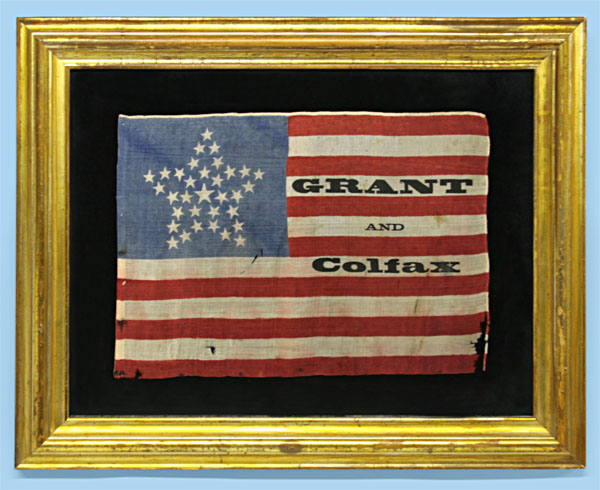
| |
33 STAR SILK PARADE FLAG FROM THE 1868 PRESIDENTIAL CAMPAIGN OF GRANT & COLFAX |
|
| Available: |
Sold |
| Frame Size (H x L): |
21" x 26.5" |
| Flag Size (H x L): |
12.25"x 17" |
|
| Description....: |
|
33 STAR OVERPRINTED SILK PARADE FLAG FROM THE 1868 PRESIDENTIAL CAMPAIGN OF ULYSSES S. GRANT & SCHUYLER COLFAX, AN UNDOCUMENTED EXAMPLE WITH A BEAUTIFUL "GREAT STAR" CONFIGURATION AND A "DOUBLE-X" ON COLFAX:
33 star parade flag, printed on silk, used in the 1868 presidential campaign of General Ulysses S. Grant & Schuyler Colfax. Among printed flags, those made for political campaigns with text or pictorial advertising are the most valuable. Within this group, the flags made for the most memorable historical figures, such as Lincoln and Grant, are highly sought after. This is also true of the earliest campaign flags, those made for obscure candidates, and those made for candidates who's campaigns resulted in the production of scant few advertising flags.
Also important are a flag's visual presentation and the elements it includes. Made for the first campaign of one of America's most beloved figures, the stars of this particular flag are configured in what is known as the "Great Star" pattern, a large star made out of smaller stars. There was no official configuration until 1912, so the star pattern was left up to the desires of the flag-maker, and all manner of styles were pursued.
The candidates' names are overprinted in black ink in wide, somewhat exaggerated text. The bold overprint has nice folk appeal, largely due to the whimsical "double-x" at the end of Colfax's name. The overall visual appeal and general desirability that results from the Grant association are further heightened by the fact that it is the only known example in this style that has thus-far surfaced. Not only is it one-of-a-kind, but it is also one of the only political flags I can recall that has a Great Star configuration that is unencumbered by additional stars that create wreath patterns, or stars that flank the central pattern in each corner. Sometimes simplicity is better, and this is often the case with variations of the Great Star.
Among flag collectors and general observers alike, the Great Star configuration is undoubtedly the most coveted of all 19th century geometric patterns. Shortly after the War of 1812, American naval hero, Captain Samuel Reid, suggested to the president that the Great Star should be considered to become the first official star design. Reid's primary concern was that, as more and more states joined the Union, our flag needed to be kept recognizable on the open seas. Naval use was the primary reason for the American ensign in the first place, and Reid's proposal would have kept the star constellation in roughly the same form, and in an easily recognized design that could be quickly identified through a spyglass as the number of states grew. Reid's proposal was rejected due to the increased cost of arranging the stars in this manner. Never-the-less, since there was no official star pattern, the great star was produced by anyone willing to make it. Its rarity today, along with its beauty, has driven the desirability of American flags with this configuration.
The 33 star flag was official between the years of 1859 and 1861. Political flags sometimes do not have star counts that reflect the date in which the candidate ran for office, so it is not that unusual to find a 33 star flag used in an 1868 campaign. Probably the purchaser of the flag liked the star pattern and chose it from what the flag manufacturer had in stock. Either the flag (or flags, if multiples were made) had been leftover from an earlier time, or a pre-existing print block was used to make flags to the buyer's specifications for size and design. It may even be the case that a 33 star flag was preferred because it was the official star count at the opening of the Civil War, drawing an association between the general and his significant role in Union victory. Few 33 star flags were actually produced for the war, but 33 was the official couint in April of 1861 and the flag flying at Fort Sumter when it was fired on by the Confederacy had 33 stars.
Mounting: The flag has been sandwiched between 100% cotton velvet, black in color, and u.v. protective Plexiglas. The velvet was washed and heat-treated to reduce excess dye, and an acid-free agent was added to the wash to further set the dye. The flag was then placed in a gilded molding that dates to the period between 1830 and 1860.
Condition: There are some tears and splits with associated losses, the largest of which is in the bottom, fly-end corner and includes the separation of a piece of a small piece of the hem. There is also minor fading, foxing, and staining from some of the metal tacks that once held the flag to its staff. This is excellent condition for such a rare silk flag, however. The flag's beautiful overall presentation, accompanied by its one-of-a-kind status, far outweigh any condition issues. |
|
|
|
| Collector Level: |
Flags for the truest Patriots. My best offerings |
|
| Flag Type: |
Parade flag |
|
| Star Count: |
33 |
|
| Earliest Date of Origin: |
1868 |
|
| Latest Date of Origin: |
1868 |
|
| State/Affiliation: |
Oregon |
|
| War Association: |
1866-1889 Indian Wars |
|
| Price: |
Sold |
|
| |
Views: 3556 |
|
|
|

